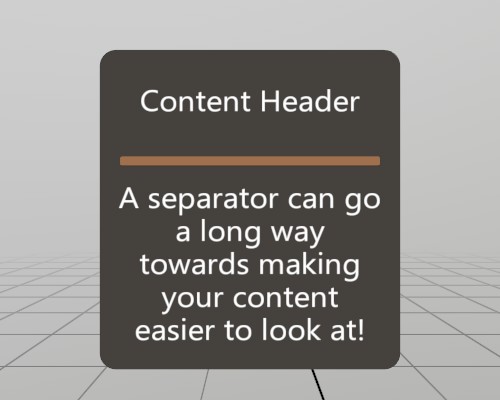UI.Label
static void Label(string text, bool usePadding)
Adds some text to the layout! Text uses the UI’s current font settings, which can be changed with UI.Push/PopTextStyle. Can contain newlines!
| string text | Label text to display. Can contain newlines! Doesn’t use text as id, so it can be non-unique. |
| bool usePadding | Should padding be included for positioning this text? Sometimes you just want un-padded text! |
static void Label(string text, Vec2 size, bool usePadding)
Adds some text to the layout, but this overload allows you can specify the size that you want it to use. Text uses the UI’s current font settings, which can be changed with UI.Push/PopTextStyle. Can contain newlines!
| string text | Label text to display. Can contain newlines! Doesn’t use text as id, so it can be non-unique. |
| Vec2 size | The layout size for this element in Hierarchy space. If an axis is left as zero, it will be auto-calculated. For X this is the remaining width of the current layout, and for Y this is UI.LineHeight. |
| bool usePadding | Should padding be included for positioning this text? Sometimes you just want un-padded text! |
Examples
Separating UI Visually

A separator is a simple visual element that fills the window horizontally. It’s nothing complicated, but can help create visual association between groups of UI elements.
Pose windowPoseSeparator = new Pose(.6f, 0, 0, Quat.Identity);
void ShowWindowSeparator()
{
UI.WindowBegin("Window Separator", ref windowPoseSeparator, UIWin.Body);
UI.Label("Content Header");
UI.HSeparator();
UI.Text("A separator can go a long way towards making your content "
+ "easier to look at!", TextAlign.TopCenter);
UI.WindowEnd();
}
Found an issue with these docs, or have some additional questions? Create an Issue on Github!
